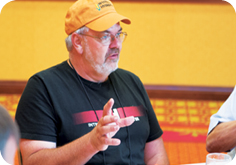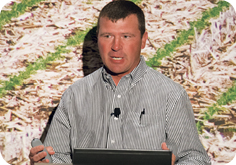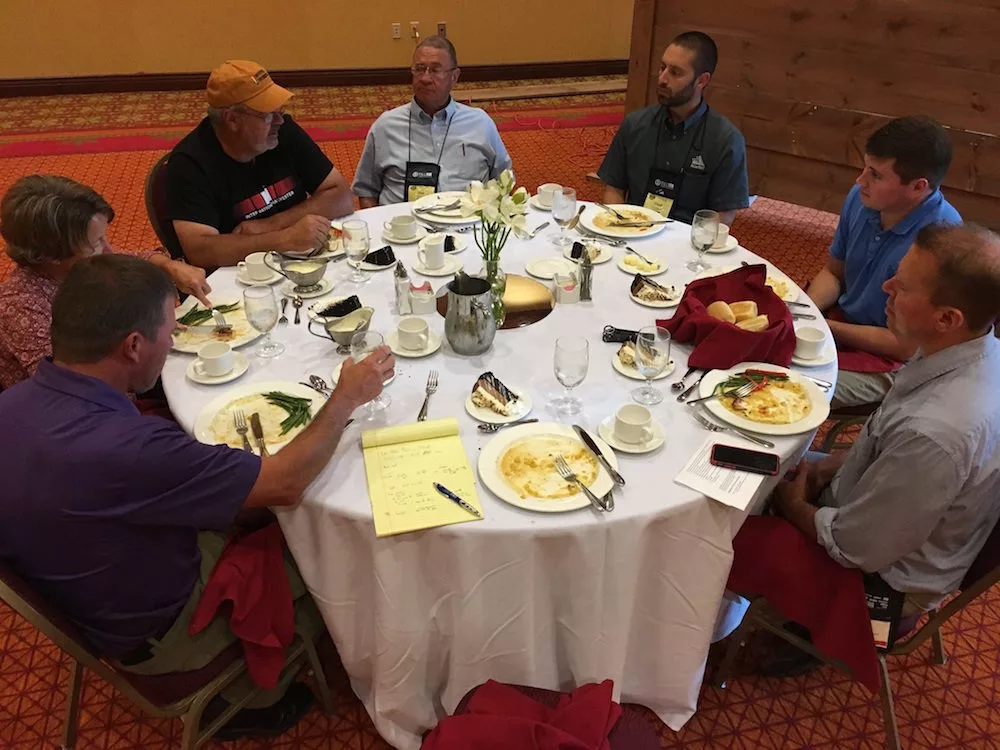A Precision Farming Dealer Staff Report
Precision farming tools are a part of many strip-tillers’ systems, and while technology often improves efficiency and productivity, it can also pose adoption challenges.
Our editors assembled a diverse group of farmers at the 4th Annual National Strip-Tillage Conference in Omaha, to discuss strategies, objectives and outcomes of utilizing precision farming systems, as well a influential factors when making precision purchases and the significance of having a reliable support network.
At the table were Kerry and Angela Knuth from Mead, Neb., Jeff Reints from Shell Rock, Iowa, and Tim Leischner from Parkston, S.D. Below are excerpts from the conversation, and you can listen to a podcast of the conversation at www.PrecisionFarmingDealer.com.
QPFD: Where do you see the greatest technology void in your farming operation, or need for improvement on the precision side?
Jeff Reints

“We look first at the dealership, and how long our specialist or salesperson has been there, and the quality of people. We need that dealer support...”
Jeff Reints: “It would be nice if one monitor could control everything within our Case IH tractor and our 24 row planter. We have a Pro 700 monitor now in our tractor cab, but I think companies are getting closer to where we can also run our 24 row strip-till rig, which is a Harvest International UltraMax 60 series 60 foot toolbar with Dawn Pluribus coulter-style row units, with a Montag high output dry fertilizer delivery system. But at the time we got it, the software wasn’t available. We’re a single-mix application and we can change the rate of that mix but we can’t change the ratio of phosphorus and potassium on the go, which would be beneficial.”
Kerry Knuth: “Communication between machines. I want the day I can control where a piece of equipment goes in the field before it goes there. For example, having the ability to monitor my sprayer operator in the field so he doesn’t have to make up his mind which direction he wants to go.
“Everything needs to be compatible with the software I use back in the office, so everything can be drawn up into one platform. I don’t even know how many different software platforms we use. But if we could just have one program for all our prescriptions, whether it’s seed, fertilizer, path of the field or guidance lines, that would be ideal. My wife, Angela, could have everything loaded before we even get to the field vs. saying, ‘I did one part in Precision Planting for your planting, but now I’ve got to go work with the Trimble system for the guidance lines. It’s just stressful.”
Angela Knuth
“Sharing data between the different colors and different monitors with some of the background software packages is a challenge. We know a solution is coming but it needs to happen...”
Angela Knuth: “It would be nice not to have to take a USB stick out into the field because I forgot to upload something. And it’s usually the field that’s farthest away. Another challenge for us is sharing data between the different colors and different monitors with some of the background software packages. We know it’s coming but it needs to happen.”
QPFD: Thinking about some of the technology investments you’ve made, what are some of the biggest influences in those purchasing decisions?
Reints: “We look first at the dealership, at how long our specialist or salesperson has been there, and the quality of people. We need that dealer support. Our precision technician isn’t a planter or strip-till expert, he’s not a combine expert and he’s not a data expert. But he understands the entire ball of wax and can come up with a solution for the system, compared to somebody who’s more or less trying to sell the equipment the support is just a piece that goes with it.”
Knuth: “I’m going to go on just the side of the technology. We like to be innovators, but we’re not just looking for the next shiny, new toy. It’s got to benefit us. We’ve got the yield monitor in our Claas combine connected to Precision Planting’s 20/20 system for our 48 row John Deere planter. We get very good accuracy out of that with an iPad. We don’t necessarily like the data going to the cloud, but we have to have that. We can see when one row is messing up and we’ll catch it.
“We’ve been prototyping it in our wheat this past year. It’s going to be great in the corn and soybeans, to be able to put all the yield information from the 20/20 so the planter information will be back in the office and it will merge really well.”
Tim Leischner
“I know technology will do a lot of it. But on the human side, where is the breaking point?...”
A. Knuth: “And down the road, that will be more important when we’re variable-rating or whatever. That will make a big difference, if we want to go back and have a check when we’re out in the field, because otherwise, we don’t get back to it in the wintertime as often as we should.
“But we had to educate ourselves initially because we got tired of being charged for data transfer and downloading or uploading files by our supplier. We were never taught how to use it, but we were getting charged for it. Once we figured it out, we were able to work with our local dealer in the system.”
Knuth: “Titan Machinery out of Fremont, Neb., ended up hiring the specialist we had been working with at another dealership which sold Trimble. We have pretty mixed fleet of machinery with Claas and AGCO tractors, a Deere planter and a Blu-Jet strip-till rig. We wanted to continue running the Trimble stuff and our specialist was right there with a solution. Him being there and telling us that we can make the compatibility work, convinced us that it could, and it has.”
QPFD: What do you see as the next game-changing innovation that will benefit your farming operation?
Reints: “I don’t think it will be in my lifetime, but the autonomous planter. Right now we’re running a 24 row Case IH planter and there’s a lot of weight and mass to that machine. If I can downsize to an autonomous 8 row machines behind a 90 horsepower tractor, that will hardly leave any footprint in the field.”
A. Knuth: “Sensor data or sensors would really help direct our daily activities during the seasons. Then the ability of an autonomous little drone going out and diagnosing problems in the field would be valuable. Is it an insect problem? Is it a fungicide problem? A lot of sensors are going to be out in the field, but right now they’re not cheap enough to get enough of them out there to manage problems to the level we want to.”
Kerry Knuth

“We like to be innovators, but we’re not just looking for the next shiny, new toy. It’s got to benefit us…”
Tim Leischner: “It’s all about the money.”
A. Knuth: “Absolutely. Right now, we use the moisture sensors. But we can only afford one out in the field. We can you can get electrical conductivity (EC) readings map our soils, but that doesn’t tell us what’s going on day-to-day.”
Leischner: “That’s true. I guess I really wonder, speaking from an old-school perspective, how fast do we have to keep going? I mean, it seems like every year, we have to do twice as much twice as fast just to stay even. And where is the breaking point? I know technology will do a lot of it. But on the human side, where is the breaking point?”
Reints: “And on that same line, at what point are we just in an information overload? We’ve studied every yield map, layered them in for all the years we’ve been collecting them. There is megabytes of data sitting in our computers that probably could be analyzed. And every 2 or 3 years, when we trade combines, it’s a different software that might not be compatible with what we were using.
“At some point, there’s just the good old seat-of-the-pants, you-know-how-to-farm mentality. It’s still a hell of a lot more fun to grab a 6-pack and the wife and go count corn at night. You can’t do that with an iPad and a sensor.






